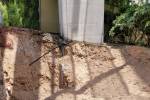Restaurant inspections go online
Concerned that mice droppings are adding unwanted spice to the goulash at your favorite restaurant? Worried that slime in the ice machine now makes a bourbon on the rocks at your favorite eatery taste like bourbon on the dirty socks?
Well, Las Vegans, thanks to the Southern Nevada Health District's use of the Internet, it's now easier than ever to find out what health inspectors have learned after they stick their noses in a food establishment's business.
That's right: With just a click of a mouse -- no, not the kind found in some kitchens -- you can find Clark County restaurant inspections for the past five years at www.snhd.info.
"We receive requests for this kind of information regularly, and this just makes it more convenient," said Steven Goode, a health district manager who oversees the work of 85 inspectors.
In the past, it cost $1 per page for concerned eaters to get the information from the health district on a restaurant inspection. The Las Vegas Review-Journal carries some inspection information in the Taste section each Wednesday.
"We inspect every restaurant no less than once a year and most facilities at least twice a year," Goode said.
The public's easy access to inspection reports for 800 facilities -- the new health district policy went into effect Monday -- doesn't make Katherine Jacobi, president and CEO of the Nevada Restaurant Association, sick to her stomach. But she isn't shouting praises over the new policy either.
"We hope people understand that an inspection is just a snapshot in time," Jacobi said. "You can have a restaurant that's perfect 99.9 percent of the time, but on the day the inspector comes out, something might go wrong."
The restaurant association strongly supports food safety, Jacobi said. But association officials have met with health district inspectors to express their concerns, particularly whether inspectors will quickly add the corrective measures by a restaurant to the website.
"Sometimes a restaurant will correct a problem the same day," she said. "But then you've got to get the inspector back out to your restaurant, and then he has to put it up on the website."
Stephanie Bethel, a spokeswoman for the health district, said her agency should be able to get an inspector back out to a restaurant within 24 hours. And then it should only take another 24 hours to show on the website that the eatery has corrected its problems.
An "A" grade, Goode said, is what the Health Department wants from restaurants. When an inspection finds that the restaurant has fallen beneath that grade -- even to a "B" -- the restaurant has 10 days to make corrections. A "C" grade brings a $442 penalty to the restaurant owner.
If restaurant owners have not called the health district for a reinspection within 10 days, an inspector will go back to the property. Goode said it's very possible the restaurant could be closed if major problems persist.
Less than 10 percent of Clark County restaurants fall beneath an "A" at any one time, Goode said. There are four to 10 closures of restaurants each month, he added. The closure of an eatery carries a $716 penalty to the owner.
Frank Pacheco, who with wife Josefina owns Frank & Fina's Cocina at 4175 South Grand Canyon Drive near West Flamingo Road and the Las Vegas Beltway, said he is happy that the health district has made inspections more public. He proudly displays his "A" grade in his restaurant
"People should know where it is safe to eat," he said. "We don't want people getting ill eating at a restaurant. I try to make sure that everyone sees we get an 'A' grade."
Richard Monarque, owner of the Lunch Stop Cafe at 2644 S. Highland Drive, isn't pleased with inspections being reported on the Internet.
A week ago an inspector gave his restaurant a "C" grade, with 37 demerits that included not having effective measures in place to control pests. There were problems with thawing of food and keeping it at the right temperature. There also were plumbing problems with inadequate hand-washing facilities and improperly cleaned surfaces that come in contact with food.
Monarque believes the inspector doesn't like him or his family.
"Until she came on last year, I didn't have problems," he said.
In 2009, his restaurant graded at a "C" and had 39 demerits. According to the health district's website, in six previous inspections from 2005 to 2008 by other inspectors, Monarque's restaurant had 5 "As" and one "B."
"How did I get so bad so fast?" he said. "I operated 16 restaurants at one time in California without any problem. Nobody gets sick at my restaurant. For some reason this woman doesn't like me."
The health district's Bethel said Monarque is encouraged to call the inspector's manager if he believes the process isn't fair.
The restaurant association's Jacobi believes the new system will eventually work. But she doesn't like the fact that a restaurant's inspection reports are on the Web for the past five years.
She said that opens up the opportunity for fraud, "to people who don't have the best intent in mind."
A person who got sick four years ago, she said, might look on the Internet to see a restaurant had a bad inspection report at that time and then try to sue years later.
What will make the system better, she said, is when health inspectors can upload corrective measures taken by restaurants in real time with new sophisticated handheld computers.
"They had problems in New York with this at first, too," she said, "but it worked out for everybody."
Contact reporter Paul Harasim at pharasim@review journal.com or 702-387-2908.
Southern Nevada Health District restaurant inspections























